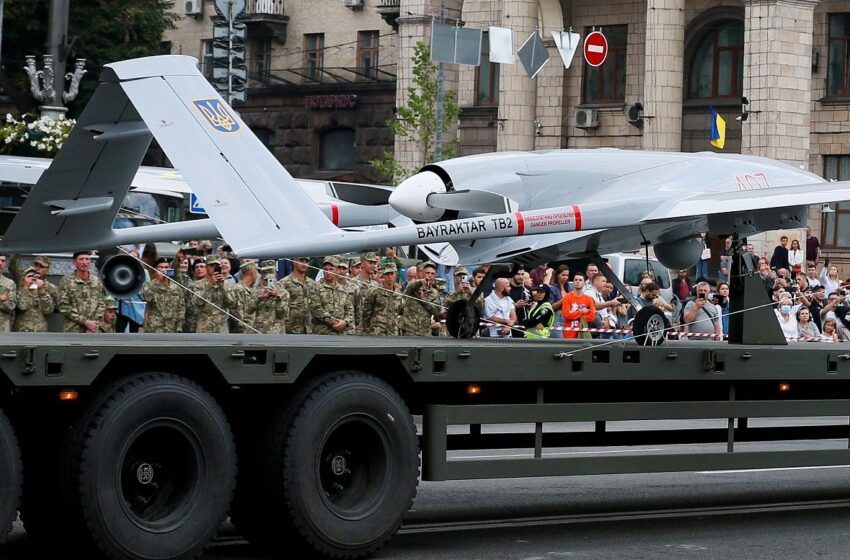
Don’t Let Ukrainian TB-2 Drones Rehabilitate Turkey’s Image
Turkish drones have helped Ukraine defend against Russia’s invasion. But the Bayraktar TB-2 has a darker history of civilian casualties and human rights violations.
Source: National Interest
A Turkish Bayraktar TB-2 drone operated by the Ethiopian government killed fifty-nine civilians in a camp in Tigray for internally displaced persons in January. Earlier in March, Turkey’s killer drone was trending on social media after the Kyiv zoo named a newborn lemur “Bayraktar.”
While Turkey’s TB-2 drones have been celebrated for their effectiveness in fending off Russia’s assault, their fetishization has left the victims of Turkey’s war industry concerned by the accompanying rehabilitation of Ankara’s public image.
Turkey’s drones first came to prominence when they helped put an end to the Syrian army’s advance on Idlib in early 2020. The drones were difficult to detect by radar and caught Syrian forces off guard. International observers were also surprised. The affordable UAV was viewed as a game-changer.
Considerably less attention, however, has been dedicated to the devastating toll these weapons have had on civilians—and Turkey’s willingness to deploy these weapons of war in the service of ethnic cleansing and genocide.
The use of Turkey’s Bayraktars by despots is not merely coincidental. It is exactly the purpose they were designed to serve.
The impetus for Turkey’s drone program was inherently violent. The program sought to overcome the geographical barriers to its efforts to subdue Kurdish resistance in the country’s southeast.
For years, Turkey relied on Israel and the United States to access drone surveillance to track down Kurdistan Workers’ Party (PKK) insurgents. But relying on these foreign operators exposed Turkey to foreign surveillance, and limited Turkey’s capacity to act immediately on intelligence. In some cases, it led to impulsive strikes that resulted in massive civilian casualties. After a breakdown of relations with Israel in 2010 and increasing tensions with the United States, Ankara was determined to find a domestic solution. It was in this vacuum that Baykar Defense, already manufacturing small reconnaissance drones for the Turkish army, began manufacturing the TB-2. The new drone was successfully tested to widespread acclaim in 2015.
The TB-2 was first put into use in 2016 shortly after a truce between Turkey and the PKK broke down. The truce dissolved when it was discovered that Ankara had surreptitiously provided support to ISIS during its siege on the Kurdish-majority city of Kobani. Kurds erupted in protest across the country, leading to an escalation of violence that Turkish president Recep Tayyip Erdoğan was determined to put down by any means necessary.
Under the guise of “counterinsurgency,” drones have rained terror on civilian populations, resulting in massive casualties and the forced displacement of thousands. Turkey’s liberal interpretation of the term “terrorism” disproportionately affects Kurdish rights activists. That makes it nearly impossible to determine how many of the more than four hundred people killed in drone strikes by Turkey in the country’s southeast were civilians.
Following their success in Turkey, Ankara began deploying its drones in operations against PKK targets in Iraq and Syria. While Turkey had been using foreign intelligence to conduct extraterritorial operations for years, the TB-2 increased its capacity significantly. Despite suggestions that drone technology would reduce civilian harm, Turkey’s actions have proven otherwise. Attacks on Kurdish civilians and infrastructure are now commonplace, resulting in mass displacement in Syria’s north.
Operations in Sinjar, Iraq have terrorized the region’s indigenous Assyrian and Yazidi populations, evoking the trauma of genocide for the two long-persecuted communities. Drone strikes on medical facilities and in close proximity to refugee camps—which provide sanctuary to up to 200,000 Yazidi refugees throughout the region—have disproportionately impacted civilians, with analysis suggesting over 60 percent of strikes in the region resulting in civilian casualties.
The ruthless effectiveness of the TB-2 drone led to its widespread adoption by countries throughout the region. Perhaps the most notable example was Azerbaijan, which recently deployed TB-2s during the invasion of the Armenian-majority region of Nagorno-Karabakh (Artsakh) in September 2020. The drones played an essential role in the military advance that displaced over 90,000 civilians. The war was marked by widespread perpetration of grave human rights violations and war crimes, including the targeting and destruction of civilian infrastructure.
Recently, the use of Bayraktar drones in Ethiopia has shifted the tide of conflict. Government forces have halted the advance of Tigrayan resistance fighters and devastated civilian populations.
Ukraine’s deployment of TB-2s in self-defense amidst Russia’s invasion is not in itself problematic. However, the glorified portrayal of the drones in media and popular culture has contributed to the redemption of Ankara’s public image while it engages in the very type of belligerency and aggression the world has taken a determined stance against with regards to Russia.
In many ways, this was likely the desired effect. Turkey has played a delicate balancing act in Ukraine. Ankara is torn between its obligations as a NATO member to contain Russia’s aggression, and its desire to assert a more independent regional foreign policy. Turkey’s inclination to chart its own course has led it to cooperate with Russia on areas of mutual interest, often to the detriment of its Western allies.
Turkey’s renewed relationship with Russia has also created friction during the war in Ukraine. The Turkish government has sought to (at least publicly) distance itself from the success of the TB-2s in Ukraine. Deputy foreign minister Yevuz Selim Kiran said that the sale of TB-2s did not constitute aid to Ukraine, but was strictly business.
Even though Turkey’s government exerts a high degree of control over exports, the attempts to distance itself from anything that might be construed as overt support for Ukraine are consistent with its approach to Russia. Ankara refused to commit to any punitive political or economic measures against Moscow and delayed restricting Russia’s access to the Black Sea by implementing the Montreux Convention—a largely symbolic gesture, given that the Convention wouldn’t impede the movement of Russia’s Black Sea Fleet returning to its homeport.
Nonetheless, Turkey has managed to deftly balance its ties with Russia while earning praise for its actions in Ukraine—all while enriching its unethical war industry.
New buyers are lining up for Turkey’s drones. In addition to their current operators in Azerbaijan, Ethiopia, Turkmenistan, Libya, and Qatar, TB-2 drones have been ordered by Morocco, Kyrgyzstan, Pakistan, Iraq, and Niger. Somalia and Oman have also expressed interest. And if there’s one overlapping theme across these potential buyers, it’s their utter disdain for human rights.
The naming of zoo animals and police dogs after the Bayraktar TB-2 and the Ukrainian military sharing a song dedicated to the drone on its social media may seem innocuous, but it belies the dangers of whitewashing the sordid details of Turkey’s drone program.
As more European countries (including Poland, Latvia, Hungary, and Bulgaria) express interest in acquiring TB-2s, those concerns are being realized. The deployment of Bayraktars by Ukraine and other European powers may not pose the same risks as their use elsewhere, but this is the exception to TB-2 operators.
Romanticizing and valorizing the Bayraktars, beyond simply being ghoulish, risks sanitizing the abusive nature of Turkey’s regime and undermining global efforts to enforce human rights standards in arms exports. It also dangerously overshadows the violent impetus for their creation, and the ways in which the drones have empowered some of the world’s most abusive dictatorships. These regimes have enabled mass atrocities, ethnic cleansing, and genocide.
In the world’s efforts to contain one expansionist authoritarian regime, the United States and its allies must be careful they don’t inadvertently empower and enable others.
